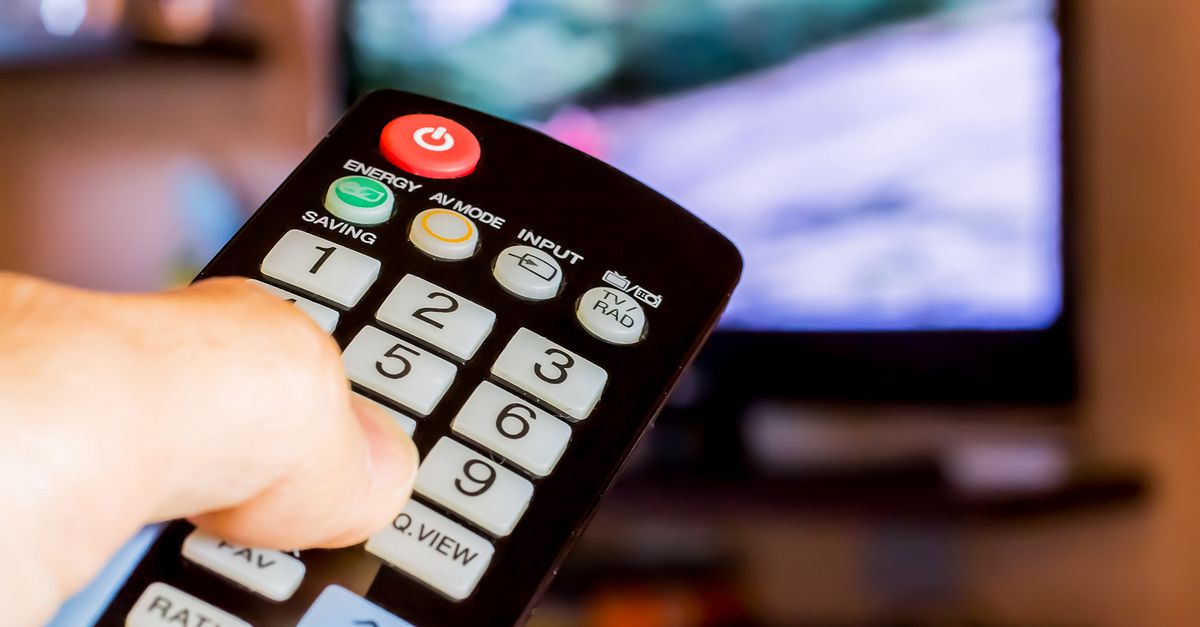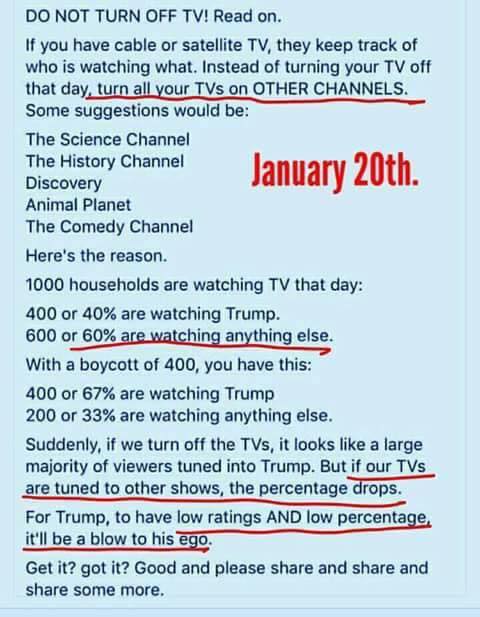A "call-to-action" message that urged television viewers to watch anything other than Donald Trump's inauguration on 20 January 2017 in an attempt to lower the event's TV ratings (and thus strike a blow to the President-elect's ego) was widely circulated on Facebook:
However, a boycott scheme similar to the described above would likely not be very effective regardless if whether viewers had their televisions turned on, off, or changed to something other than Inauguration Day news coverage.
The largest stumbling block to this plan is the assumption that each individual's personal viewership affects a given television program's ratings. This simply isn't the case — unless, of course, that individual is a member of a "Nielsen family."
The Nielsen Company gathers data to determine the ratings of television programs, and while the company employs a variety of methods to collect their data (especially in this relatively new age of Internet streaming), the most common method is via Nielsen families:
Chosen at random through proven methodology, Nielsen’s U.S. TV families represent a cross-section of representative homes throughout the country. We measure viewing using our national and local people meters, which capture information about what’s being viewed and when, and in the major U.S. markets, specifically who and how many people are watching. We also have TV set meters in many local markets, and we collect more than two million paper diaries from audiences across the country each year during “sweeps” — specific periods during the months of February, May, July and November. To measure video content viewed on mobile devices, we have expanded our panels to incorporate census-style data from third parties in order to capture the breadth and depth of consumer usage.
Nielsen households are randomly selected as a representative sample of the TV-viewing population of the United States:
"It's a very select few," explains Jon Gibs, Nielsen's senior vice president for analytics and insights. "The reason these people are picked is because they are representative of a broader population." The company goes to great lengths to make sure that each household chosen to be among the 25,000 Nielsen households stands for a large number of other people. "We make sure that our TV households maintain what we'd consider sort of normal behavior," and people are warned against changing their viewing habits just to make a particular show popular.
Since Nielsen uses these selected families to determine television ratings, the viewing habits of most people (who are not members of a Nielsen family) go largely unrecorded.
Vulture reporter Margaret Lyons addressed this issue in a 2015 Q&A:
(Q): Is there an effective way to support my favorite shows? I rarely watch the traditional way anymore, what with DVR, streaming, iTunes, and a public library with a good DVD collection. So when networks are looking at numbers to decide the fate of a show, what do they take into consideration? Tweets? Emails? Purchases? App views? Hulu? Amount of GIFs on Tumblr? Do we now live in a world where Firefly could have been saved? Does my vote "count"? —Annie
(A): The short answer is no. And the long answer is nooooooooo, your TV vote doesn't count in any meaningful way unless you're a Nielsen family, in which case you affect ratings. And ratings are what count. The various fan ephemera does not have a big or clear impact on keep/cancel decisions.
As of August 2016, there were about 40,000 Nielsen households, representing a total of 118.4 million TV-viewing households, in the United States. Steve Krakauer added more detail about how Nielsen ratings were determined in a 2015 post on Autonomous:
The households are evenly distributed by population throughout the United States, and are roughly meant to be representative of the population as a whole. They also rotate occasionally. But let’s get back to that number. Maybe 50,000 households seems like a lot to you, but to put it in perspective, there are approximately 100 million households with a TV in the United States. That means even at the high estimate of 50,000 households, the number represents .05% of the households. That would be less than 1/10 of 1%.
The ratings that you see — for cable news, for broadcast primetime shows, etc — are then extrapolated out from these Nielsen households. So in this scenario, each household represents 2,000 other households in approximating what the country is watching.
Although Nielsen isn't the only company that compiles TV ratings, they are the company that has the most influence over the purchase of television advertisements:
"For 66 years, New York-based Nielsen has calculated viewership numbers.
And since Arbitron Inc. got out of the TV ratings business in 1993, Nielsen has been pretty much the only player. Nielsen numbers have been arguably the sole basis on which local and national TV ad rates are calculated, using a ubiquitous cost-per-point formula."
It should also be noted that the way consumers watch television, and the way that Nielsen collects is data, has changed in recent years. For instance, the company inked a deal with DISH Network in April 2016 to incorporate DISH's set-top boxes into its data. However, this deal was primarily focused on enhancing Nielsen's data from small, local markets:
The Dish info is “the first nationwide dataset to be integrated with our panel data, reaching the perfect balance of deep viewing characteristics and the granularity of large datasets,” says Nielsen’s COO Steve Hasker. “As the global leader in audience measurement, this is another step in our efforts to integrate big data into our portfolio and our Total Audience efforts.”
Set top box data is especially helpful in small markets where the sample sizes for Nielsen’s surveys often are too small to give advertisers a clear sense of what niches of viewers watch.
So it’s not surprising that Nielsen will begin by blending the Dish data into reports for all 210 markets in its its Local TV Measurement service. The ratings company also will use the results in other products including Nielsen Scarborough, Nielsen Data Fusion, and Nielsen Media Custom Insights.
As Nielsen's data is largely drawn from "Nielsen families," a non-Nielsen family member's individual viewing (or lack thereof) of Donald Trump's inauguration would have virtually no impact on the event's overall television ratings.


